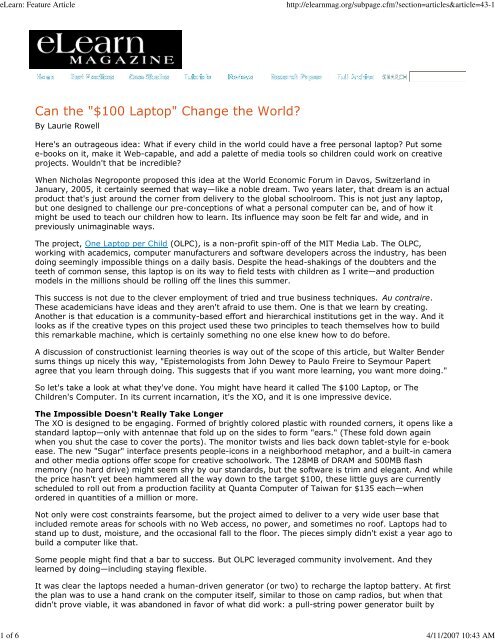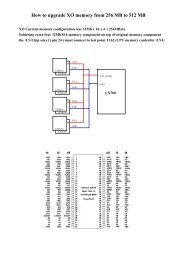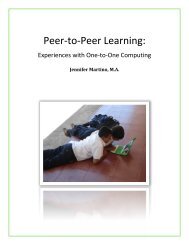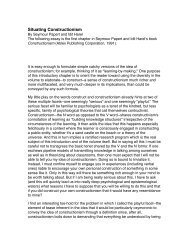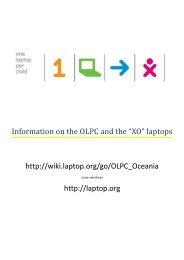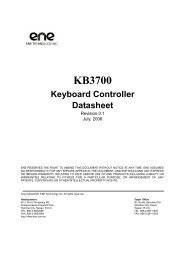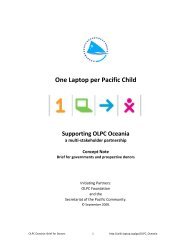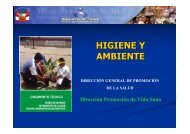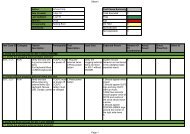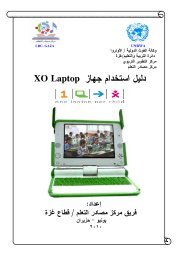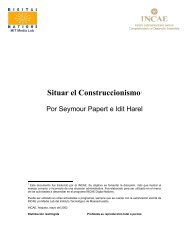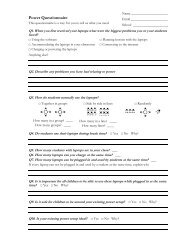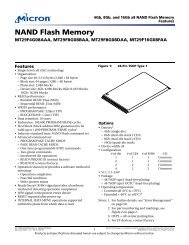eLearn: Feature Article - The OLPC Wiki - One Laptop per Child
eLearn: Feature Article - The OLPC Wiki - One Laptop per Child
eLearn: Feature Article - The OLPC Wiki - One Laptop per Child
Create successful ePaper yourself
Turn your PDF publications into a flip-book with our unique Google optimized e-Paper software.
<strong>eLearn</strong>: <strong>Feature</strong> <strong>Article</strong>http://elearnmag.org/subpage.cfm?section=articles&article=43-11 of 6 4/11/2007 10:43 AMCan the "$100 <strong>Laptop</strong>" Change the World?By Laurie RowellHere's an outrageous idea: What if every child in the world could have a free <strong>per</strong>sonal laptop? Put somee-books on it, make it Web-capable, and add a palette of media tools so children could work on creativeprojects. Wouldn't that be incredible?When Nicholas Negroponte proposed this idea at the World Economic Forum in Davos, Switzerland inJanuary, 2005, it certainly seemed that way—like a noble dream. Two years later, that dream is an actualproduct that's just around the corner from delivery to the global schoolroom. This is not just any laptop,but one designed to challenge our pre-conceptions of what a <strong>per</strong>sonal computer can be, and of how itmight be used to teach our children how to learn. Its influence may soon be felt far and wide, and inpreviously unimaginable ways.<strong>The</strong> project, <strong>One</strong> <strong>Laptop</strong> <strong>per</strong> <strong>Child</strong> (<strong>OLPC</strong>), is a non-profit spin-off of the MIT Media Lab. <strong>The</strong> <strong>OLPC</strong>,working with academics, computer manufacturers and software develo<strong>per</strong>s across the industry, has beendoing seemingly impossible things on a daily basis. Despite the head-shakings of the doubters and theteeth of common sense, this laptop is on its way to field tests with children as I write—and productionmodels in the millions should be rolling off the lines this summer.This success is not due to the clever employment of tried and true business techniques. Au contraire.<strong>The</strong>se academicians have ideas and they aren't afraid to use them. <strong>One</strong> is that we learn by creating.Another is that education is a community-based effort and hierarchical institutions get in the way. And itlooks as if the creative types on this project used these two principles to teach themselves how to buildthis remarkable machine, which is certainly something no one else knew how to do before.A discussion of constructionist learning theories is way out of the scope of this article, but Walter Bendersums things up nicely this way, "Epistemologists from John Dewey to Paulo Freire to Seymour Pa<strong>per</strong>tagree that you learn through doing. This suggests that if you want more learning, you want more doing."So let's take a look at what they've done. You might have heard it called <strong>The</strong> $100 <strong>Laptop</strong>, or <strong>The</strong><strong>Child</strong>ren's Computer. In its current incarnation, it's the XO, and it is one impressive device.<strong>The</strong> Impossible Doesn't Really Take Longer<strong>The</strong> XO is designed to be engaging. Formed of brightly colored plastic with rounded corners, it opens like astandard laptop—only with antennae that fold up on the sides to form "ears." (<strong>The</strong>se fold down againwhen you shut the case to cover the ports). <strong>The</strong> monitor twists and lies back down tablet-style for e-bookease. <strong>The</strong> new "Sugar" interface presents people-icons in a neighborhood metaphor, and a built-in cameraand other media options offer scope for creative schoolwork. <strong>The</strong> 128MB of DRAM and 500MB flashmemory (no hard drive) might seem shy by our standards, but the software is trim and elegant. And whilethe price hasn't yet been hammered all the way down to the target $100, these little guys are currentlyscheduled to roll out from a production facility at Quanta Computer of Taiwan for $135 each—whenordered in quantities of a million or more.Not only were cost constraints fearsome, but the project aimed to deliver to a very wide user base thatincluded remote areas for schools with no Web access, no power, and sometimes no roof. <strong>Laptop</strong>s had tostand up to dust, moisture, and the occasional fall to the floor. <strong>The</strong> pieces simply didn't exist a year ago tobuild a computer like that.Some people might find that a bar to success. But <strong>OLPC</strong> leveraged community involvement. And theylearned by doing—including staying flexible.It was clear the laptops needed a human-driven generator (or two) to recharge the laptop battery. At firstthe plan was to use a hand crank on the computer itself, similar to those on camp radios, but when thatdidn't prove viable, it was abandoned in favor of what did work: a pull-string power generator built by
<strong>eLearn</strong>: <strong>Feature</strong> <strong>Article</strong>http://elearnmag.org/subpage.cfm?section=articles&article=43-12 of 6 4/11/2007 10:43 AMPotenco that looks like a yo-yo. This might be good for all of us as Potenco plans to market theseseparately for those who might want to keep a lamp aglow—if not our power-munching laptops—shouldour own grid fail.How do you get a tiny laptop powered by foot or string power to connect to the Web? Not with a router.<strong>The</strong> <strong>OLPC</strong> will use Marvell's 88W8388 wireless chip, an implementation of the emerging 802.11s standardfor mesh networking. <strong>The</strong> mesh network model allows laptop-to-laptop connection, making each device, ineffect, an access point. Peer laptops connect to the server at the school for Web service. Since the Marvellchip doesn't access the laptop's CPU, there are savings for the power bottom line as well. Field tests inmid-January using two XO laptops in the Australian outback show impressive connectivity for distances ofover a kilometer. (A simulation of the mesh network available on the <strong>OLPC</strong> Web site lets you drag the peerlaptops to connect them to one another and to the "world.")Where do you find a monitor for an inexpensive child's laptop when conventional LCDs cost $130 apiece tomanufacture? A new technology might be problematic, as the monitors have to be churned out by themillions once production gets a green light. To top it off, the monitors have to o<strong>per</strong>ate in full sunlightbecause that's where some developing countries hold class.Some solutions you just have to build yourself. Mary Lou Jepsen, Chief Technology Officer at <strong>OLPC</strong>, tookon the challenge. She decided she needed to stay with LCDs to leverage that manufacturing base.Because the color filters accounted for a third of the cost of manufacture and a large hunk of powerusage, she replaced this conventional technology with a refraction grating that splits the backlight into itscomponent colors. <strong>The</strong> result is a brighter display with less power drain.<strong>The</strong> redesign itself was a coup, providing a power-efficient brightly lit display for a mere $35 in productioncosts. But consider that this new monitor went from concept to working prototype in a matter of months,with all boards cleared for mass production. When was the last time you worked on a large project thatintroduced a radical technology improvement on a grand scale that went from concept to solid form in lessthan a year with no outstanding bars to production and distribution?Yeah, me neither.Something has gone radically right here. And that's been done despite the overall complexity of theproject. When so many folks think outside the box, getting everything back into the box so it works rightrequires serious tweaking.Jepson agrees, offering an example of back-and-forth that happened when her monitor turned out betterthan expected. It seems the monitor was "higher resolution in color mode than the UI people reallyunderstood or the standard Web page style sheets or standard way of doing displays account for. <strong>The</strong> UIpeople were skeptical that the resolution would also be high in color 'backlight on' mode."Original designs were based on these more modest expectations and surprise meant revisions. "<strong>The</strong> fontswere initially much bigger than need be and didn't show off the high resolution of the screen—five timeshigher resolution than a standard LCD screen," Jepsen explains.This ten-second window into <strong>OLPC</strong>'s process suggests unexpected results and necessary reworking occurfor them as they do for develo<strong>per</strong>s everywhere. But somehow on multiple phases of this project the <strong>OLPC</strong>team has been delivering in months what takes others years to complete. It suggests things are thingsgoing on behind the scenes at <strong>OLPC</strong> that companies across America should consider.<strong>The</strong> "Free" Software AffrayDespite the importance of this project to everyone involved, it has run into its fair share of conflicts. Asignificant one involves the included software, which is all "free"—meaning "to be used and modifiedwithout restriction"—with one exception.<strong>The</strong> fly in the ointment is the firmware in the Marvell mesh network chip. According to Richard Stallman ofthe Free Software Foundation (FSF) "the wireless chip needs non-free firmware that needs to be installedas a file in the computer so it can be downloaded into the wireless chip when the system boots." This wasnot a simple matter of choice; no other chip could provide wireless networking at power- and price-levelsthat suited <strong>OLPC</strong>. But this chip was built using a proprietary microkernel that Marvell does not own,resulting in the non-free firmware.Now this might seem like a fine point, but to Stallman and others at the FSF who are dedicated to the
<strong>eLearn</strong>: <strong>Feature</strong> <strong>Article</strong>http://elearnmag.org/subpage.cfm?section=articles&article=43-13 of 6 4/11/2007 10:43 AMnotion of software for and by the people (including rights to use, modify, and share code as necessary),this is no small matter. "A non-free program denies the user's freedom," says Stallman, "and myconscience forbids me to recommend the use of one. This means that as long as the <strong>OLPC</strong> requires use ofthat non-free firmware, I can't promote use of the <strong>OLPC</strong> as I would otherwise wish to." He acknowledgeshow far the project has come toward meeting what he sees as an essential goal, but for him it doesn'tmake it to the finish line. "<strong>The</strong> <strong>OLPC</strong> gets 99 <strong>per</strong>cent of the way to rejecting freedom-trampling software. Ihope that someday they will get all the way there," says Stallman.<strong>The</strong> 99 <strong>per</strong>cent figure could represent an uneasy truce between Richard Stallman and Walter Bender,<strong>OLPC</strong> President of Software and Content. <strong>The</strong> open atmosphere of software development for <strong>OLPC</strong> has letcontributors examine, revise, dogfood, re-examine, and streamline code until what goes on the XO isincredibly trim—and, well, free.Again, this project is supported by the philosophy of education that underlies it, which is not just anidealistic stance in this case, but a concrete commitment to principles—like listening to dissent,communicating with all those involved in the project, and refining work as it evolves.<strong>The</strong> Educational Sticky-TrapWalter Bender has been clear in saying that education could benefit from a paradigm that allows morecritical evaluation from people at all levels, and he's frank in suggesting that the traditional schoolhierarchy is a barrier to quality improvement. In his words, "the education community, because of theway school and (<strong>per</strong>haps more significantly) school systems are structured, typically top down, tends tosuppress the spread of best practice as it is developed bottom-up in the classroom."It's hard to argue with the idea that a top-down hierarchical structure suppresses good ideas from inspiredpractitioners (like students and teachers), as it short-circuits criticism of prevailing conditions that mightmake the system self-correcting. <strong>The</strong> problem is, many existing school systems might refuse to acceptthat philosophy. So as children across the planet suddenly have access to one another and to a rich mineof information through the XO, will education and schools conflict—as so often they do? How will thechanging educational landscape fit with existing schoolroom models?Ethan Zuckerman is an activist and researcher based at the Berkman Center for Internet and Society atHarvard Law School. He has traveled widely in the developing world and has studied <strong>OLPC</strong> in depth. Hesees places the <strong>OLPC</strong> laptop might meet resistance as it bumps up against cultural practice, physicalconsiderations, and teaching styles. "Some—not all—classrooms in the developing world work under avery authoritarian model, where the teacher uses techniques like recitation, repetition, and lecture to theentire class to maintain tight control of student behavior," says Zuckerman.Some of the problems he sees in schoolrooms in the developing world are echoed here in our own halls oflearning. "Educational systems that teach to standardized national tests mean that the emphasis is onmaking sure a <strong>per</strong>centage of students learn enough information to pass the national exams, and less onlearning through self-guided exploration, which is what the <strong>OLPC</strong> project is designed to enable."Classroom issues that might conflict with laptop use are not limited to the developing world, which issomething that becomes clear as Zuckerman talks about what he calls "less-direct ways in which <strong>OLPC</strong>might prove subversive within the classroom."Unfortunately some of the most innovative and education-supportive features of the laptop could causethe greatest problems. "<strong>The</strong> o<strong>per</strong>ating system of the laptop is designed around the idea of'presence'—you're aware of every other laptop in your proximity, and you can send messages to each ofthese other laptops. Imagine a room filled with students capable of passing digital notes to each other atevery point during a lesson—many teachers would find this a potentially troubling development,"Zuckerman suggests.You think?And if that's not enough to unnerve a teacher who isn't sure how to integrate technology, Zuckerman hasmore. "I'll offer a third concern based on my own ex<strong>per</strong>ience teaching at one of America's top law schools—students armed with Internet-connected laptops can be very intimidating to teach. Any assertion youoffer as a teacher, they can challenge with Google. (And believe me, when you're teaching lawyers, theywant to challenge you.) I can imagine some teachers finding this ex<strong>per</strong>ience of being challenged on factssufficiently frightening to heavily constrain computer use in the classroom."
<strong>eLearn</strong>: <strong>Feature</strong> <strong>Article</strong>http://elearnmag.org/subpage.cfm?section=articles&article=43-14 of 6 4/11/2007 10:43 AMStudents busy using these computers as learning tools, say in small groups in competition with oneanother to solve problems on a joint project quickly, would have no time to challenge a teacher withGoogle searches or distract each other with private e-notes. But organizing that kind of activity requires ahuge up-front investment on the part of the teacher, while saying "put away your laptops" does not.I worked in education back in the days when computers entered the curriculum in this country. I walkedkids through the Logo curriculum developed by Seymour Pa<strong>per</strong>t, and for the most part the children got acreative kick from programming the little triangular character, controlling what it did. But creative use ofcomputers did not become a classroom staple. Within a few years of my teaching ex<strong>per</strong>ience, my ownchildren went to schools where computers only ran applications that supported schoolwork as it hadalways been done. In other words, the old paradigms won that round. But the education specialistsworking with <strong>OLPC</strong> are way ahead of me here. <strong>The</strong>ir writing on the subject of what went wrong has beenpenetrating and thorough. <strong>The</strong>y have kept up.Learning to LearnWalter Bender recognizes these devices could devolve into electronic worksheets, but the hope is thatthese laptops will give everyone involved in education a chance to do something different. "We areworking from a foundation that all children (all humans) are (1) teachers and learners; (2) social; and (3)expressive," he says.<strong>The</strong> laptop is designed to facilitate these processes. "By focusing on tools of exploration andexpression—rather than instruction—in an environment that emphasizes collaboration, sharing, andcritique, we think the laptop will become the agency for engaging children in constructing knowledge—to'learn learning.' "In this regard, Bender is enthusiastic that they are able to empower young learners with creativeopportunities that I never was able to offer to my students twenty years ago. "In practice this means wikisrather than just document viewers, music composition tools rather than just MP3 players."SJ Klein, the <strong>OLPC</strong> Content Director, elaborates, "<strong>One</strong> of the next activities to be finished is going to be anapplication for recording video, and taking a set of videos and choosing different ways to splice themtogether." Such options certainly comprise a better palette of tools for integrating these computers intogeneral curriculums. And the fact every child in a school has access to the same toolset offers anopportunity for the synergy of healthy competition in creative categories.<strong>The</strong> very design of the device—small, portable, and <strong>per</strong>sonal—makes it a more effective educational tool,too. Spokespeople for <strong>OLPC</strong> have been vocal in their insistence that the computer lab, being an isolatedlearning environment, cannot be integrated usefully into the curriculum as a whole. <strong>The</strong> laptops, bycontrast, remain with the children all day and can go home with them to be used not just by the students,but by their parents and siblings.Zuckerman agrees the form factor is significant. "<strong>The</strong>y'll be integrated into students' learning in a way thatcomputers rarely are in the developed world. Even if schools don't use the full potential of the devices, it'slikely that some students will teach themselves—and each other—how to use the machines at home." He'senthusiastic, too, that texts are delivered using wiki technology. "While I suspect we're not going to seemany classrooms rewrite the texts distributed by the ministry of Education, the ability to comment onthese texts, to collaboratively take notes and to challenge facts in a text, is a critical skill set that thetechnology is likely to encourage."Content is designed to involve students in their education on several levels. SJ Klein talks about offeringstudents the tools to connect "with communities of creation within their culture and elsewhere in theworld." This means offering more than text. "We are currently working with the Free Culture movement,who are curating a collection of free music," says Klein. "We are working with the world digital library anda number of museums around the world both to make digitized snapshots of world culture available tolaptop users, as inspiration and to provide a sense of the world's diversity."Zuckerman touches on a final point that really never was a factor when computers were introduced tostudents the first time around. "I think the idea of making the machine an e-book reader and makinglibraries available by creating document caches at schools is quite important. Access to texts is a hugeproblem in many developing nations. It's important to realize that the laptop project is also a libraryproject."<strong>The</strong> <strong>OLPC</strong> laptops are scheduled to ship with the equivalent of 100 e-books on board. And that's a learning
<strong>eLearn</strong>: <strong>Feature</strong> <strong>Article</strong>http://elearnmag.org/subpage.cfm?section=articles&article=43-15 of 6 4/11/2007 10:43 AMopportunity that everyone can get behind.A little while ago I took my lunch break, walking down to the coffee shop at the end of my street. Whenthe lady at the lunch counter asked me what I was working on, I told her about the <strong>OLPC</strong> project. I ran onfor a bit about how it worked as I fumbled to put my credit card back in my wallet. When I looked up ather again she was smiling."That's awesome," she said.Yeah, isn't it?Reprinted from ACM netWorker Magazine.Laurie Rowell is a freelance writer living in Issaquah, Washington.From: fbonzo(email)noneBrilliant!Date:02/22/200709:10:25Regarding both the <strong>OLPC</strong> and this writeup--trulybrilliant and awesome.From: Roger Chrisman(email)Founder of <strong>Wiki</strong>gogy.orgTimestamp?Date:03/03/200706:37:12I love this article. When did you publish it here?(Comments show dates but your article showsnot its own). Could you take this matter up withyour publisher? Thanks! :-)Comment on this articleNote - your email address will be kept confidentialand will not be visible to other users.CommentTitleYourNameYourEmailYourAffiliationYourCommentFrom: Jimbo(email)educatorReally?Date:03/06/200709:50:13Really? What every kid needs is a laptop with100 books on it? Many of the kids inunderdeveloped countries would certainlyappreciate this and would very likely come upwith a million uses that I could not even imaginefor the thing. But how do we really know this iswhat they need? Maybe they need a good pairof runners, or a ball, or a hug everyday? I'm notconvinced that computers are the answer to theworld's children. I always remember thecardboard box the toy came in was the best toy.Submit QueryFrom: Bismillah Kader(email)Internexia InstituteHow dowe takethisforward?Date:
<strong>eLearn</strong>: <strong>Feature</strong> <strong>Article</strong>http://elearnmag.org/subpage.cfm?section=articles&article=43-16 of 6 4/11/2007 10:43 AM03/09/200703:18:10We are keeping a close eye on this project, notleast because a bunch of these machines in thehands of school kids in developing countries (oranywhere) will require teachers who have beenthrough our teacher training project whichprovides skills and content just right forenhancing learning. It's an astonishingly closematch, I believe. Please provide us withinformation on how to take this forward. BismillaKaderFrom: Ken Korman(email)Executive Editor, <strong>eLearn</strong> Magazine<strong>OLPC</strong>InquiriesDate:03/12/200709:04:04We're not sure what you mean by "take thisforward," but you can direct any <strong>OLPC</strong>-relatedinquiries to information@laptop.org. Thank you!Accessibility <strong>Feature</strong>s Media Kit Writers' Guidelines About Us Contact Us


